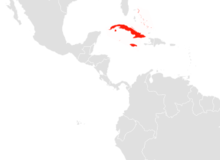Yellow-brown flower bat
| Yellow-brown flower bat | ||||||||||||
|---|---|---|---|---|---|---|---|---|---|---|---|---|

Erophylla sezekorni planifrons |
||||||||||||
| Systematics | ||||||||||||
|
||||||||||||
| Scientific name | ||||||||||||
| Erophylla sezekorni | ||||||||||||
| Miller , 1906 |
The yellow-brown blossom bat ( Erophylla sezekorni ) is a bat species from the leaf-nosed family , which is native to the Bahamas and the Greater Antilles . The species was named after Privy Councilor Eduard Sezekorn (1796–1869) who collected the holotype of this species.
Until 2003 the brown -fronted blossom bat ( Erophylla bombifrons ) was regarded as a subspecies of the yellow-brown blossom bat, but has been listed as a separate species since then.
description
The yellow-brown blossom bat is a medium-sized neotropical bat with a head-to-trunk length of 70 to 75 mm and a weight of 15 to 18 grams. This makes it slightly larger than its sister species Erophylla bombifrons . They have a tail and a rudimentary nasal blade. The fur is two-colored, about 8 mm long with hair that has a white base and a maroon tip.
Way of life
Little is known about the way of life of the yellow-brown blossom bat. Like most bats, it is nocturnal and feeds primarily on nectar and pollen, but also on fruits and insects. This diet makes them an important seed disperser and pollinator of many night-flowering plants. During the day the animals hang in small and relatively cool caves in groups of up to 650 individuals, with the sexes separated from one another. Known predators of Erophylla sezekorni are slender boas and barn owls .
Reproduction
The mating system of the yellow-brown blossom bat is promiscuous , whereby both the males and the females can mate with several partners. During the mating season from November to January, the males individually or in small groups within the colony occupy small territories (similar to leks ) and court around the females. While hanging upside down, they flap their wings vigorously, fly short standardized loops and produce special courtship calls in the ultrasonic range . The males also produce a garlic-like scent in a gland above the eye, which is probably also used for courtship.
After a gestation period of 4 to 5 months, the females usually give birth to a single young animal, which weighs an average of 4.6 grams, in early summer (May / June). The young are born hairless, but already with visible canine teeth. In August the young animals reach the size of a full-grown individual. As with most bats, only the females care for the young.
distribution
The yellow-brown blossom bat occurs in the Bahamas , the Cayman Islands , as well as in Cuba and Jamaica . Their population is classified as safe by the IUCN .
Web links
literature
- RJ Baker, PV August, AA Steuter: Erophylla sezekorni In: Mammalian Species . No. 115, 1978, pp. 1-5.
swell
- ^ Timm, RM, Genoways, HH 2003. West Indian mammals from the Albert Schwartz Collection: Biological and historical information. Scientific Papers of the University of Kansas Natural History Museum 29, pp. 1-47.
- ↑ Rodríguez-Durán, A. 1996. Foraging ecology of the Puerto Rican boa (Epicrates inornatus): bat predation, carrion feeding, and piracy. Journal of Herpetology 30, pp. 533-536
- ↑ McFarlane, DA, Garrett, KL 1989. The prey of common Barn Owls (Tyto alba) in dry limestone scrub forest of southern Jamaica. Caribbean Journal of Science 25, pp. 21-23
- ↑ Murray, KL, Fleming, TH 2008. Social structure and mating system of the buffy flower bat, Erophylla sezekorni (Chiroptera, Phyllostomidae). Journal of Mammalogy, 89, pp. 1391-1400
- ↑ Soto-Centeno, A., Kurta, A. 2003. Description of fetal and newborn brown flower bats, Erophylla sezekorni (Phyllostomomidae). Caribbean Journal of Science 39, pp. 233-234
- ↑ Baker, RJ, Hoofer, SR, Porter, CA, Van den Bussche, RA 2003. Diversification among New World leaf-nosed bats: an evolutionary hypothesis and classification inferred from digenomic congruence of DNA sequences. Occasional Papers, Museum of Texas Tech University 230, pp. 1-32
- ↑ Erophylla sezekorni in the IUCN Red List of Endangered Species .
